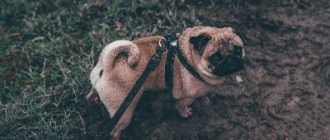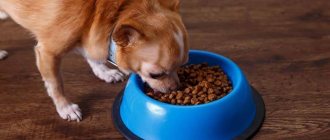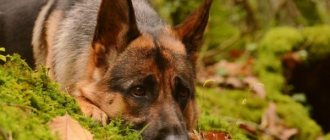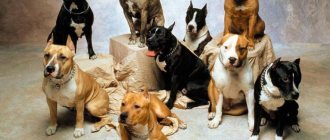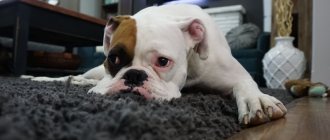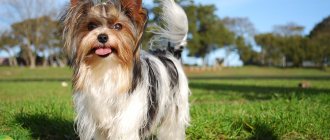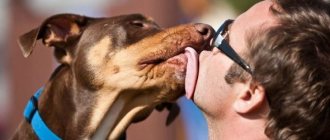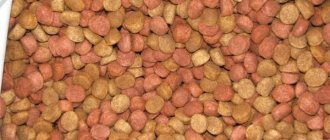What to do if your pet refuses food? Why does my dog eat poorly? What if there are also problems with water consumption? Or has she started eating something atypical? Such questions are always alarming and require an urgent response.
The importance of nutrition for a dog.
Nutrition for a dog is one of the most important components of life, which largely determines its health. As for all other animals. It comes to the fore for them, unlike a person. So, a healthy adult dog can live for about 2 weeks without food. Subject to availability of water. However, veterinarians advise seeking help if your pet refuses to eat for more than 2 days. The reasons for a puppy’s refusal to eat should be urgently identified within 12 hours.
Insufficient nutrition itself sooner or later causes:
- exhaustion;
- weakness and muscle dystrophy;
- decreased skin tone and sagging;
- decreased immunity;
- unfavorable changes in hormonal status;
- exacerbation of all chronic diseases;
- aggression and destructive behavior may appear.
The most final consequence of hunger is, accordingly, death.
Why does the dog eat poorly? Possible reasons for refusing to eat.
- An acute (or exacerbation of a chronic) disease. This can be either an infectious infection or helminthic infestation, or poisoning or a disease of the gastrointestinal tract.
- The dog does not eat any new food or its component well. This can be observed with a sudden change in food.
- Feeding by strangers (family members) not in the presence of the owner leads to an incorrect assessment of the pet’s nutrition. This can also happen during a walk if the dog picks up food scraps among the garbage, discarded food scraps, preferring a trash can or trash heap to a home bowl. A well-fed dog may refuse to eat, confusing the owner and causing anxiety. It happens that the owner himself interrupts her appetite with unscheduled treats, or maybe neighbors in the private sector feed her through the fence. Or the dog ate very heavily the day before.
- A pet manipulating a compassionate owner is capable of begging for treats and treats in this way.
- Lack of usual conditions for feeding: noisy, crowded or simply unusual place. A dog does not eat well if it is scared or overexcited about something.
- Bitches in heat or immediately before giving birth also lose their appetite. In males this is observed during the period of sexual heat. When moving to a new home, puppies also eat poorly at first. In general, a stress factor can negatively affect the nutrition of any dog. For example, renovations have begun in the apartment, a new pet in the family, extreme heat.
- Spoiled food. Table food unsuitable for dogs, rich in spices and salt.
- Thirst. If you give your dog something to drink, his appetite will return.
- Longing for the departed owner.
When lack of appetite does not need to be treated
Lack of appetite in a dog does not always require treatment. If physiological and psychological factors and weather conditions contributed to this, then there is no serious cause for concern.
Such animal behavior can be caused by the following factors:
- Someone in the family secretly fed the dog, which led to a violation of the regime.
- Improper storage of feed, which led to the appearance of foreign odors.
- The pet regularly receives table scraps.
How to solve a dog's food problem.
Accordingly, to solve such a problem, you need to identify a negative factor and try to eliminate its influence.
This is especially true for suspected disease - immediate contact with a veterinarian is necessary. You should pay attention to whether there are other serious symptoms accompanying food refusal. This may include refusal of water (!), loss of coordination of movements, discharge from the eyes or nose, drooling, abnormal bowel movements, changes in body temperature, vomiting and other signs of illness.
You can check why your dog is not eating well by giving him treats. A healthy dog will not refuse it either. If there is no suspicion of the disease, the following measures may help:
- Active and long walks;
- Refusal of unscheduled treats, especially from the table;
- Exclusion of unsuitable foods from feeding.
- Transfer to another food is also allowed;
- The time allotted for feeding should be strictly limited to 5-15 minutes. The food bowl should be removed regardless of its emptying. It must be stable and match the size of the dog.
- You can stimulate your appetite with a piece of something salty (small!). Or imitate trying to eat food from a dog bowl yourself. Many dogs are not inclined to share food and rather begin to absorb food themselves.
And, of course, it is unacceptable to shout at the dog, use physical force, or try to force feed it.
How to Tell if Your Spitz Is Eating Enough
Adequate nutrition and a balanced diet are two different things. However, as far as whether your Pomeranian is consuming enough calories, it's really a simple matter of monitoring your puppy or dog's weight.
For puppies. The #1 element to pay attention to is whether your puppy is gaining, maintaining, or losing weight. From birth to approximately 9 months, the Pomeranian should gain strength.
© shutterstock
The fastest growth that owners will notice will be between 8 weeks and 6 months of age.
Growth slows down from 6 months to 9 months. Between 9 months and 1 year, many will experience some growth, but it will not be too noticeable.
So, the puppy must eat enough to gain weight. There will be periods of rapid growth and some resting phases... however, in general for Pomeranians under 6 months of age, if there is no improvement within 2 weeks, it indicates a problem.
If your Pomeranian puppy is not eating to the point of losing weight, this indicates a serious problem that requires professional attention.
Adults—adult Pomeranians 1 year of age and older—should eat enough to maintain their weight.
Transfer to natural food if the dog does not eat dry food well.
Replacing dry food with natural food often leads to a number of positive changes in the pet’s condition. With proper natural feeding, the dog begins to look healthier in appearance. Her behavior changes: her mood, activity, learning ability, and desire to perform training exercises increase. Allergic manifestations disappear, the condition of the coat improves. This is dictated by obtaining all nutritional components in a more natural and natural form. Not refined or synthetic. Including vitamins and mineral sources.
However, such an effect is possible only with properly balanced and, at the same time, sufficiently diverse nutritional components. This only means that in addition to meat, it is necessary to include vegetables, fish, cereals, eggs, fruits, herbs, and dairy products in the diet. Some dogs will also be indicated for additional nutritional supplements or products. That is, in addition to animal protein and fats, the receipt of carbohydrates, fiber, a full set of vitamins and a number of other necessary substances must be ensured. In this case, the composition of a single feeding should be approximately the same from time to time.
True, the transfer process can be somewhat complicated due to the dog’s getting used to eating pellets. As a result, the dog does not eat unusual foods well. However, this quickly passes. But there are situations when, for some reason, the owner is still forced to do the opposite. That is, transfer the dog from natural food to dry food.
Briefly about the main thing
- Refusal from dry food occurs for various reasons;
- First of all, health problems are excluded;
- Dry diets are chosen strictly from the premium class and above;
- They are accustomed to drying, following the rules: gradualness, firmness, attention to health;
- During the hot period, appetite decreases and the need for water increases;
- Feed sold by weight is often expired and of poor quality.
How did you get your dog used to dry food? Were there any refusals from drying? For what reasons? How did you solve this problem? Tell us about your experience in the comments, please.
Did you like the article? Share it with your friends on social media. networks. This will help them get useful information and support our project.
The dog does not eat dry food well.
A situation often occurs when a dog is switched from natural food to dry food. Lack of habit to pellets leads to refusal of food for some time. Until the dog gets hungry. But there are failures even against the background of the initial diet of “crackers”. Of course, the cause may be illness. Anything accompanied by intoxication. Whether it is an infection or a disease of the digestive system. An obvious disease is immediately noticed and its treatment begins. Some hidden processes require an in-depth examination by a veterinarian.
But there may be other reasons:
- Malaise for various reasons. This could be overwork, overheating, the result of stress, or deterioration in health after vaccination. There may well be a temporary refusal of food due to a change in the situation in the house: the presence of strangers, renovations, a new dog from the neighbors. For a pet, many subtle factors can lead to stress.
- Damage to teeth, gums, and mucous membranes of the mouth while chewing hard objects. This can happen at home, especially in a puppy when teeth change. Or on a walk, when the pet is left to its own devices. For example, during the massacre of a found bone.
- There is no clear feeding rhythm. This leads to disturbances in appetite and may at some point cause food refusal. Since the pet is not always hungry at the time of feeding. Each dog has its own feeding schedule, once or twice a day for an adult. Usually after a walk.
- Insufficient physical activity when walking. In cold weather, walking time may be reduced. Then energy costs are reduced. And that means the need to fill them.
- Sudden changes in diet, the dog does not eat new food well. A short-term fast (1-2 days) will help solve the problem.
- Poor quality food that has spoiled or has exceeded its shelf life. Oils (fats) contained in feed oxidize over time. A rancid taste appears. The dog may well refuse such food.
- Elementary spoiling. When a dog is pampered with treats, it may then turn away from regular food. And waiting for something tastier. Moreover, the persistence in this is sometimes amazing.
Chihuahua does not want to eat, drink and is sad
As we indicated in the previous section, various symptoms can alert us and indicate that the Chihuahua is unwell and therefore its appetite is reduced. Therefore, before taking any steps, you need to make sure that the dog is healthy.
But when should we worry? If your Chihuahua has always been a good eater and suddenly stops showing appetite, or it declines and loses desire, we should start to become concerned, as loss of appetite is one of the first signs of illness in dogs.
You should go to the vet if your Chihuahua is not eating or drinking and is showing any of the following signs:
- Lack of appetite
- Doesn't drink water
- Weight loss
- Lethargy
- Heat
- Excessive sleep
- Tremor
- Vomit
- Diarrhea
- Depression
A dog exhibiting these symptoms is most likely sick. Most often this is gastritis, gastroenteritis, the presence of internal and/or external parasites or infections. Likewise, there are many other reasons. The main thing is to visit a veterinarian to find out why your Chihuahua is not eating and is sad.
Another aspect that can also occur is pain or discomfort in the mouth. Chihuahuas are prone to tartar and mouth problems, so this discomfort may cause your little one to stop eating. Check for sores, bad teeth, swelling, objects between teeth, or any other strange features in the mouth that may cause pain.
If you are convinced that your small dog has one or more of the symptoms described, or you are not sure where his lack of appetite and sadness are coming from, we recommend that you visit your veterinarian to resolve the problem as soon as possible.
© shutterstock
What can you do?
- Take a closer look at the dog’s well-being, at its lifestyle, to see if anything has appeared that distracts, interferes with, or stresses it out. Try to reduce or remove possible unnecessary stressors. Don't distract her while she eats. Eliminate any negative factor at this time. Do not scold or praise near the bowl. Any encouragement is permissible only after eating.
- Examine the dog's mouth and the condition of its teeth. Usually it is not difficult to notice damage, swelling, and inflammation. Sometimes changing the size of the granules can help. Your dog may not be able to eat pellets that are too large.
- Establish a consistent feeding schedule. Do not change food frequently. You should not take risks by buying food at a discount at a promotion, which is already approaching its sell-by date. Or buy a huge bag for the future for a small dog. Get a special container for closed food storage.
- Provide your pet with active walks with games and physical activity. Do training exercises.
- Do not give your pet food from the table - only in his bowl. During meals, the owner and his family should send the dog to its place. And do not give in to plaintive pleading glances, sighs and other gestures. If the dog persists, show firmness and persistence.
- Leave food in the bowl for no more than 15 minutes, after which the bowl should be removed until the next feeding. No matter how much is eaten.
- If there are several dogs, it is better to feed them separately.
She's a picky eater
It would be great if you could just buy a 10kg bag of dry dog food every month or so and feed it to your German Shepherd for years to come. Unfortunately, your German Shepherd may not eat because he is a picky eater. If he is used to getting treats or leftovers as a snack, why should he settle for dry dog food?
So, are German Shepherds picky eaters? The fact is that it is usually the owner who makes his dog a picky eater! A little healthy treat, especially fruit or vegetables, every now and then is okay.
© shutterstock
Rules for transferring from natural food to dry food.
- Gradual change of diet - in parts. However, not all dogs tolerate alternating natural food with dry food well. With weak digestion, this can cause dyspepsia. But a number of dogs will be better off switching to dry food with this method. You can alternate feeding different foods, reducing the amount of dry food for several days. Mixing dry lump natural foods in a bowl is not recommended due to their different digestion rates. A sudden change in feeding type can lead to digestive problems.
- For the transition period, preference should be given to the highest quality feed. Often a dog will not eat food that is past its expiration date due to the rancid smell of oxidized fats.
- Maintaining proper drinking regime. Clean water in a bowl should be available in sufficient quantity at all times. At least 100 ml per kg of body weight per day. Replacement of water with fresh water should be done 2 times a day.
- During the transition period, it is advisable to use probiotics, but this is only possible as prescribed by a veterinarian.
- Dry food is recommended for puppies from 4 months of age. It is not advisable to switch older dogs to dry feeding. For an older pet, such events are very stressful. It is extremely undesirable to change the diet for pregnant bitches, unless absolutely necessary. Changes in the usual feeding of bitches during the period of milk feeding of puppies are unacceptable.
She likes to eat at certain times of the day
Just like you might not want to eat breakfast at 6 a.m., your dog may have a habit of only eating at certain times of the day. While it may be concerning at first, you should keep an eye on how much food your German Shepherd eats overall throughout the day.
If he is still eating about the same amount, he may prefer to eat at certain times of the day!
My German Shepherd usually ate one in the morning and one in the evening. However, now that she is older, she prefers to eat both meals in the evening. She won't eat them all at once (this is not recommended to prevent bloating), but she will eat them 2-3 hours apart, which is fine.
Article by: Sharon Waddington I have a German Shepherd named Willow and have been working with dogs for almost 30 years. I love spending time with her and love sharing my knowledge and experience on all things dog related on this site!
Dehydration.
Problems with eating disorders can also be directly related to the dog’s fluid intake. Therefore, if a dog eats poorly and refuses water, you should sound the alarm.
Water balance and its importance.
Like all mammals, water metabolism is extremely important for a dog's body. Water is involved in almost all life processes. This is both the circulatory system and the digestive system. Water is involved in thermoregulation and is found in all tissues and organs. The excretion of water through the kidneys ensures water-electrolyte and acid-base balance and the removal of toxins. In a word, not a single process in a dog’s body occurs without the participation of water.
Lack of water replenishment for 10-14 hours leads to incipient dehydration. Therefore, the dog’s access to water should be almost constant, especially in hot weather. Dehydration in the heat disrupts thermoregulation processes and threatens serious cardiovascular disorders.
The amount of fluid a dog drinks per day may vary and depends on a number of factors. It's not just the ambient temperature. This also includes physical activity, the size of the dog, and the nature of the food received. For example, dry food requires more water than natural feeding. Or a yard lifestyle in winter may provide access to snow as a source of moisture. Typically, a dog fulfills its need for fluid instinctively. In cool weather she drinks less, and this is normal.
But there are conditions accompanied by a decrease in fluid intake, which should require attention to the pet. Or even cause anxiety, being a manifestation of the disease.
Reasons for refusing water.
- Dirty dishes and stale water. Chemical impurities or bacterial contamination present in water from an unsafe source. In such cases, the dog will only sniff the water bowl. A bowl that has been unwashed for a long time accumulates dirt from the fur on the face, remnants of saliva or food. This is a good substrate for the active reproduction of pathogenic bacteria. Usually, a dog also does not eat well from unwashed dishes due to the unpleasant odor.
- Late pregnancy or immediate postpartum period in females. Usually, refusal of water during these periods is short-lived and does not always manifest itself.
- The recovery period after surgery accompanied by anesthesia.
- Damage and diseases in the mouth area, especially the tongue. Painful tongue movements interfere with the normal drinking process.
- Upper respiratory tract diseases. Swelling of the larynx and pharynx during viral respiratory diseases often causes difficulty swallowing.
- Common serious diseases: viral and bacterial infections, poisoning, oncological processes, some diseases of the urinary tract.
Therefore, refusal of water should alert you and serve as a reason to contact a veterinarian. And, of course, the drinking bowl should be washed daily, and with detergents - at least once a week. The water must be used clean and strictly potable. One that you yourself could use.
The puppy refuses to drink water.
In very young puppies, cases of refusal to drink water often occur. Weaned from the bitch, they gradually wean themselves off their mother's milk, learning to feed on their own. At the same time, their instinct to lap up the water “awakens.” And usually there are no problems with this.
But there are situations when a baby is deprived of maternal milk feeding very early, or even from birth. Then this instinct may appear belatedly. And at first the puppy simply does not know how to lap. In addition, if he receives the volume of necessary fluid from food, there are no motivating factors for this.
Over time, switching to a less liquid diet, he will learn to lap up water from the bowl. To speed up this moment, you can lightly dip the muzzle in a bowl of water. If this does not help, you need to use a bottle with a nipple. If the puppy is thirsty, he will be able to drink. But usually such situations are rare. Since at a very early age, even without mother's milk, the puppy receives only liquid food. And there is no need for additional drinking.
The situation with refusal of water at a more independent age speaks, rather, of poor health. Even in the absence of any accompanying abnormal symptoms, this is a reason to contact a specialist. The reasons may be:
- viral or bacterial infection;
- poisoning;
- foreign body of the pharynx or esophagus;
- intestinal obstruction;
- congenital anomalies of the digestive system.
In such situations, appetite is usually impaired.
Dehydration is a sign of illness.
If your dog is not drinking enough water, there may be cause for concern. Especially if it is combined with other abnormal symptoms. This may be lethargy, apathy, reluctance to play or go for a walk, the dog eats poorly or refuses food altogether. Externally, changes may appear in the eyes: dimming of the iris, redness of the whites. In order to determine the presence or absence of a lack of water (dehydration), there are two ways:
- By pulling the skin on the withers (between the shoulder blades) with two fingers, you can determine how the fold returns. If it is slow, the dog is dehydrated.
- Assessing the condition of the gums. The gums of a healthy dog have a rich pink color. When you apply light pressure with your finger on the gum, a lighter area appears for a short time, which quickly disappears. Longer disappearance is a sign of lack of water.
Also, dehydration can often be combined with a distinct decrease in body weight and even exhaustion.
What will a long-term restriction of water consumption lead to:
- lethargy, decreased motor activity;
- decreased skin tone, joint dysfunction, pain while walking;
- decreased overall metabolism and dysfunction of all internal organs;
- slowing down the excretion of metabolic products and general intoxication;
- exacerbation of existing chronic diseases;
- exhaustion and subsequent death.
Therefore, you need to respond to signs of dehydration as soon as possible.
How to help a dog.
Even before contacting the veterinarian, if symptoms of dehydration appear, you should try to give your dog something to drink. Of course, you can’t force her to drink, it’s impossible. Therefore, in emergency situations, you can pour some liquid into the mouth with a syringe or syringe. This may be Ringer's solution or Regidron, used to treat dehydration. If the drug is not available, you can use chicken broth or carrot juice, diluting them with water by half. Or at least just water. This may help reduce dehydration symptoms before seeking qualified veterinary care. In a veterinary clinic, your pet will be given emergency drip infusion treatment. Force feeding of dogs is unacceptable.
If the whole issue is not some kind of disease, the necessary conditions should be created so that the pet receives the required amount of water. And so that this is facilitated by favorable conditions of detention. But you can try to create more comfortable conditions for this. This:
- feeding strictly at a certain time of day;
- constant access to drinking water;
- eliminate stress factors as much as possible; it is unacceptable to scold a dog if it does not drink;
- take water with you on long walks;
- Provide a healthy dog with adequate daily exercise.
Excessive water consumption by a dog is polydipsia.
In fact, it is a scientific synonym for the word “thirst.” If there is thirst, as a rule, the dog eats poorly, even to the point of completely refusing food. However, the reasons for this phenomenon may be different. In any case, this is a reason to take a closer look at the condition of your pet. Try to determine if everything is okay with him.
- Increased ambient temperature. It's hot indoors and/or outdoors. Large amount of physical activity. Such situations are immediately visible and lead to a one-time increase in the need for fluid.
- Deficiency of protein in the diet, excess of table salt. Dry food in the diet also requires more fluid intake than natural feeding.
- Chronic thirst can accompany chronic intoxication - household (detergents) products, low-quality food.
- Polydipsia with diabetes mellitus, certain kidney and liver diseases, and increased body temperature. The situation is especially serious if the pet, in addition to thirst, also loses its appetite. Urgent veterinary attention is needed.
- The use of certain drugs: diuretics, anticonvulsants, hormones.
What measures will help prevent this undesirable phenomenon?
- Reduce salt intake from food to a minimum, exclude prohibited foods. Sodium is needed - but it is found in sufficient quantities both in dry food and in many natural products.
- When switching from natural feeding to dry food, it is better to do this gradually.
- Eliminate lack of protein in the diet (all kinds of mono-diets, economy-class dry food).
In any case, the dog should always have a bowl full of fresh, clean water.
She doesn't feel well
If the problem is not food, your German Shepherd may have something else going on. Serious illnesses such as cancer, kidney failure and infections can directly affect your dog's desire to eat.
Your German Shepherd may have eaten something poisonous while wandering around the garden or fields. Dogs are known for eating anything they can find that has been left lying around or even in the trash!
Be careful with foods such as chocolate or grapes and never leave them lying around where your dog can reach them as they can be very toxic.
If your German Shepherd has recently had vaccinations, they can sometimes cause adverse reactions, including loss of appetite. The good news is that this should only be a brief loss of appetite—just make sure your dog drinks plenty of water and stays hydrated.
German Shepherds need constant access to clean water, and it is recommended to change the water every few hours.
If your shepherd is struggling to stay hydrated and you're worried, you can always get a pet water fountain since the free-falling stream of water encourages your dog to drink.
If nothing seems to be working and you are concerned, you should schedule a visit to the vet as soon as possible.
The dog does not eat regular food well, but eats grass on walks.
One of the sometimes not very clear food manifestations in dogs is eating grass while walking. Many owners observe this in their pets. This always causes confusion and questions.
The reasons for this phenomenon lie in the characteristics of nutrition and digestion. Dogs' ancestors were carnivores, but the digestive system subsequently evolved. The dog has become a more omnivorous animal. In addition to the main part of nutrition - meat - she began to require sources of dietary fiber and carbohydrates. These are vegetables and grains processed by humans into digestible forms. But the evolutionarily ancient habits of the carnivorous diet of our ancestors remained to cleanse their stomachs of indigestible by-products. Such as feathers, wool, bone fragments. Such inedible things can remain in the stomach for a long time, causing discomfort. Hence the habit of systematically cleaning the contents of the stomach.
The main reasons for eating grass:
- Relief from stomach discomfort, nausea and pain. With digestive disorders, the dog does not eat its usual food well, but at the same time tries to cleanse the stomach with grass.
- Elimination of blockages, stagnant accumulations and foreign bodies in the stomach. Eating grass causes a gag reflex.
- Excessive stress, accompanied by increased tone and intestinal spasms, and sometimes bloating and constipation. In humans, a similar disorder is called irritable bowel syndrome. Only a person is treated with antispasmodics, and a dog alleviates its condition by eating grass.
- The presence of medicinal properties in some types of grass. Eating such herbs is typical only for wild individuals or those raised near humans, but in natural conditions over a number of generations.
- Playful behavior, with puppies and juveniles tearing grass with their teeth, but not eating it.
It is believed that a dog should not stop eating grass. Because it might benefit her. But one thing should be remembered. The grass eaten is not everywhere and may not always be clean and safe. In some places, it may be treated with harmful pesticides, fertilizers or other agricultural pesticides. Accidental eating of plants in natural areas that are also poisonous to dogs also happens. Therefore there is a risk of poisoning. Anemone, sedum, marigold, and buttercup are toxic to dogs. By the way, some indoor plants are also poisonous - dieffenbachia, monstera, oleander. The way out is seen in strictly defined and safe places for “grazing”. Some gardeners sow wheatgrass, wheat, and oats on their own for their pets. Decorative dogs are able to eat grass from a durable, stable box or flower pot. This kind of weed is also available in pet stores.
Therefore, if your dog is not eating or drinking well, there is cause for concern. Since a whole range of reasons for this can be identified. And some of them may require emergency veterinary care.
Yagovitin M.Yu.


